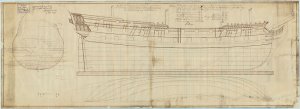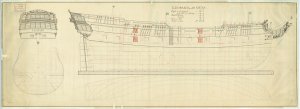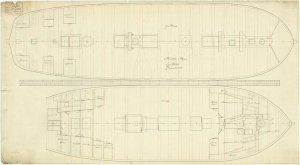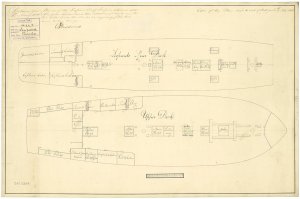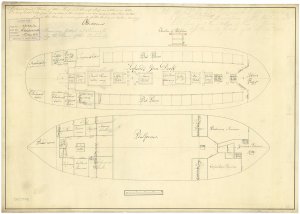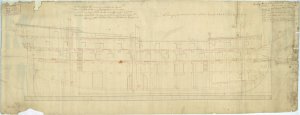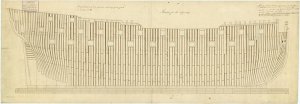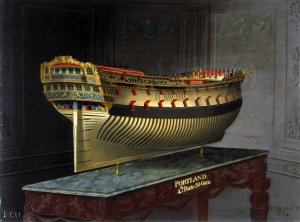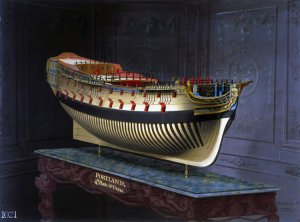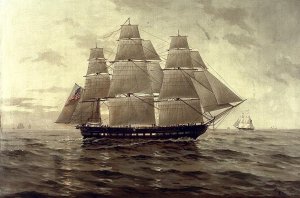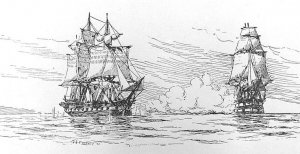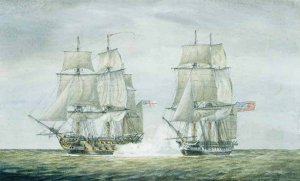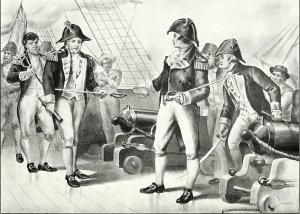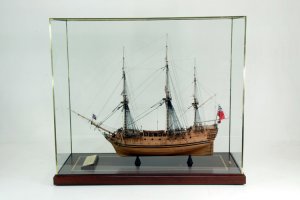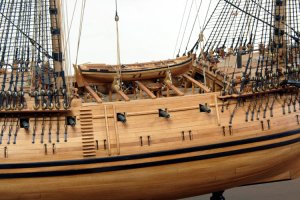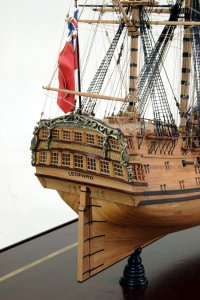Due to the fact, that I picked up once more the book "The 50-gun Ship" by Rif Winfield (see Book Review The 50-gun Ship) my interest was growing to find out more about this vessel. The information I found in the book and the web I want to summarize and share with you.
HMS Leopard 1790 - 1814 / 50-gun Ship / Portland Class
HMS Leopard was a 50-gun Portland-class fourth rate of the Royal Navy. She served during the French Revolutionary and Napoleonic Wars, and was notable for the actions of her captain in 1807, which were emblematic of the tensions that later erupted in the War of 1812 between Britain and America. She was wrecked in 1814.
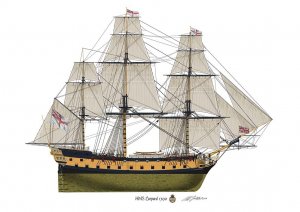
Profile Artwork offered on amazon
https://www.amazon.de/Leopard-1790-Profil-A4-glänzend-Kriegsschiff-unterzeichnet/dp/B079CQM7ZV
Construction and commissioning
She was first ordered on 16 October 1775, named on 13 November 1775 and laid down at Portsmouth Dockyard (other sources say Sheerness Royal Dockyard) in January 1776. She was reordered in May 1785, ten years after having first been laid down, and construction began at Sheerness Dockyard on 7 May 1785. Work was at first overseen by Master Shipwright Martin Ware until December 1785, and after that, by John Nelson until March 1786, when William Rule took over. She was launched from Sheerness on 24 April 1790, and was completed by 26 May 1790. She was commissioned for service in June that year under her first commander, Captain John Blankett.
This is an excerpt from the drawings of the very good Rif Winfield book "The 50-gun Ship" - here once more the link to the Book Review (click on the title) The 50-gun Ship
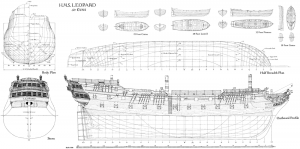
Service
The China fleet of East Indiamen left Macao on 21 March 1791. Leopard and Thames escorted them as far as Java Head.
French Revolutionary Wars
On 24 October 1798, Leopard captured the French privateer vessel Apollon, which was under the command of captain La Vaillant. On 22 August 1800 Leopard captured Clarice.
Because Leopard served in the navy's Egyptian campaign (8 March – 8 September 1801), her officers and crew qualified for the clasp "Egypt" to the Naval General Service Medal that the Admiralty issued in 1847 to all surviving claimants.
The Chesapeake-Leopard affair
In early 1807, a handful of British sailors—some of American birth—deserted their ships, which were then blockading French ships in Chesapeake Bay, and joined the crew of the USS Chesapeake. In an attempt to recover the British deserters, Captain Salusbury Pryce Humphreys, commanding Leopard, hailed Chesapeake and requested permission to search her. Commodore James Barron of Chesapeake refused and Leopard opened fire. Caught unprepared, Barron surrendered and Humphreys sent boarders to search for the deserters. The boarding party seized four deserters from the Royal Navy–three Americans and one British-born sailor–and took them to Halifax, where the British sailor, Jenkin Ratford, was hanged for desertion. The Americans were initially sentenced to 500 lashes, but had their sentence commuted; Britain also offered to return them to America.
The incident caused severe political repercussions in the United States, and nearly led to the two nations going to war.
Fate
Leopard escorted a convoy from Portsmouth on 6 May 1808. Leopard left the convoy on 28 July at 35°S 7°E.
She then was part of the convoy assigned to Josias Rowley in the Mauritius campaign of 1809–11 in the Indian Ocean.
In 1812, Leopard had her guns removed and was converted to a troopship. On 28 June 1814 she was en route from Britain to Quebec, carrying a contingent of 475 Royal Scots Guardsmen, when she grounded on Anticosti Island in heavy fog. Leopard was destroyed, but all on board survived.
From wikipedia the basic information - https://en.wikipedia.org/wiki/HMS_Leopard_(1790
A beautiful Navy Board style model of the HMS Leopard in scale 1:192 built by Gus Augustin
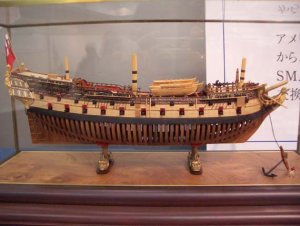
to be continued.......
HMS Leopard 1790 - 1814 / 50-gun Ship / Portland Class
HMS Leopard was a 50-gun Portland-class fourth rate of the Royal Navy. She served during the French Revolutionary and Napoleonic Wars, and was notable for the actions of her captain in 1807, which were emblematic of the tensions that later erupted in the War of 1812 between Britain and America. She was wrecked in 1814.

Profile Artwork offered on amazon
https://www.amazon.de/Leopard-1790-Profil-A4-glänzend-Kriegsschiff-unterzeichnet/dp/B079CQM7ZV
Construction and commissioning
She was first ordered on 16 October 1775, named on 13 November 1775 and laid down at Portsmouth Dockyard (other sources say Sheerness Royal Dockyard) in January 1776. She was reordered in May 1785, ten years after having first been laid down, and construction began at Sheerness Dockyard on 7 May 1785. Work was at first overseen by Master Shipwright Martin Ware until December 1785, and after that, by John Nelson until March 1786, when William Rule took over. She was launched from Sheerness on 24 April 1790, and was completed by 26 May 1790. She was commissioned for service in June that year under her first commander, Captain John Blankett.
This is an excerpt from the drawings of the very good Rif Winfield book "The 50-gun Ship" - here once more the link to the Book Review (click on the title) The 50-gun Ship

Service
The China fleet of East Indiamen left Macao on 21 March 1791. Leopard and Thames escorted them as far as Java Head.
French Revolutionary Wars
On 24 October 1798, Leopard captured the French privateer vessel Apollon, which was under the command of captain La Vaillant. On 22 August 1800 Leopard captured Clarice.
Because Leopard served in the navy's Egyptian campaign (8 March – 8 September 1801), her officers and crew qualified for the clasp "Egypt" to the Naval General Service Medal that the Admiralty issued in 1847 to all surviving claimants.
The Chesapeake-Leopard affair
In early 1807, a handful of British sailors—some of American birth—deserted their ships, which were then blockading French ships in Chesapeake Bay, and joined the crew of the USS Chesapeake. In an attempt to recover the British deserters, Captain Salusbury Pryce Humphreys, commanding Leopard, hailed Chesapeake and requested permission to search her. Commodore James Barron of Chesapeake refused and Leopard opened fire. Caught unprepared, Barron surrendered and Humphreys sent boarders to search for the deserters. The boarding party seized four deserters from the Royal Navy–three Americans and one British-born sailor–and took them to Halifax, where the British sailor, Jenkin Ratford, was hanged for desertion. The Americans were initially sentenced to 500 lashes, but had their sentence commuted; Britain also offered to return them to America.
The incident caused severe political repercussions in the United States, and nearly led to the two nations going to war.
Fate
Leopard escorted a convoy from Portsmouth on 6 May 1808. Leopard left the convoy on 28 July at 35°S 7°E.
She then was part of the convoy assigned to Josias Rowley in the Mauritius campaign of 1809–11 in the Indian Ocean.
In 1812, Leopard had her guns removed and was converted to a troopship. On 28 June 1814 she was en route from Britain to Quebec, carrying a contingent of 475 Royal Scots Guardsmen, when she grounded on Anticosti Island in heavy fog. Leopard was destroyed, but all on board survived.
From wikipedia the basic information - https://en.wikipedia.org/wiki/HMS_Leopard_(1790
A beautiful Navy Board style model of the HMS Leopard in scale 1:192 built by Gus Augustin

to be continued.......



